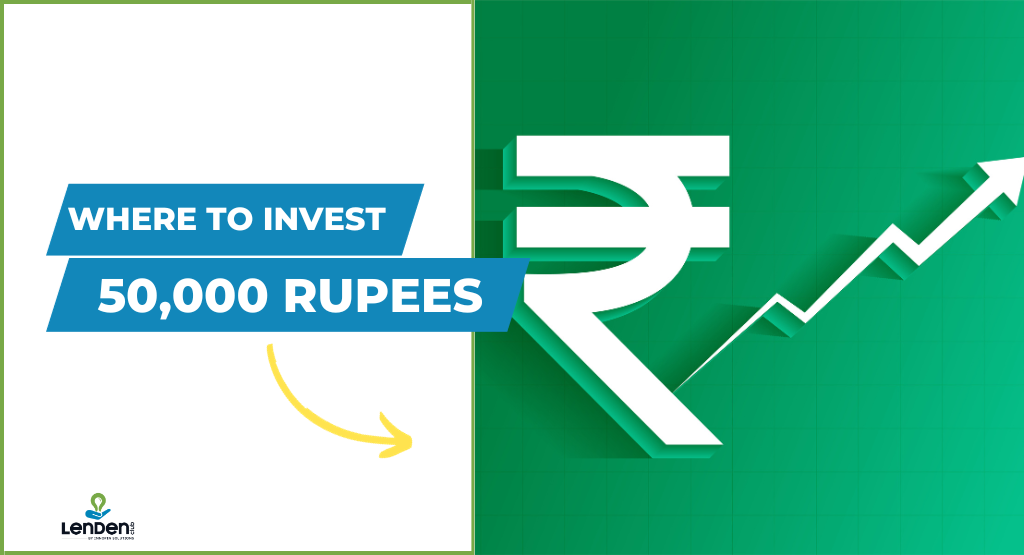Where To Invest 50000 Rupees

Are you wondering and asking yourself Where’s the best place to invest ₹50,000? It’s like a maze, and one gets lost in this maze because there are so many options to grow your money.
But no worries! It doesn’t matter if you’re a risk-taker or a mindful investor, we have a solution for you. Further, we’ll dive into investments which is ideal for someone with your budget.
We’ll cover everything from the unknown world of Peer-to-peer lending to the well-organized realm of mutual funds. Plus, we’ll touch on solid choices like fixed deposits and the stable ground of debt funds.
So, get ready! Let’s convert that ₹50,000 into an asset that will benefit your future financial well-being.
5 Best Options on Where to Invest ₹50,000
1. Mutual Funds
If you want to invest in the stock market but are feeling cautious about going into it, mutual funds could be your answer.
In mutual funds: they gather your money and then professional investors handle it. These investors invest their cash into various things—like stocks, bonds, and commodities—to spread out the risk.
These investors are the ones making the moves—buying, selling, and keeping an eye on what’s happening in the market—all intending to boost your investment.
The sweet part? Mutual funds offer flexibility and tend to carry lower risk. Why? Because your money isn’t all in one place; it’s spread across different things.
Plus, they’re super convenient. You can kick back while your fund manager does the market watch for you.
Now, picking the right one is key. Study their past performance, the goodwill and reputation of the fund house, and what kind of sectors they invest in. Choose the one that fits your financial goals and how much risk you’re comfortable with.
2. P2P Lending
It’s like having your mini bank, lending money, and getting interest. That is what Peer-to-peer (P2P) lending is; it gives you that exact opportunity.
There is no middleman involved with P2P platforms—people needing cash and people like you willing to lend it out are matched directly. It’s a direct way to assist someone while boosting your bank account.
What you can do: Sign up on a P2P platform and check out the list of borrowers. You’ll see their credit scores and what they need the cash for. Find a borrower that’s best according to you, lend your ₹50,000, and watch as they repay it along with some interest—and enjoy your extra cash!
P2P lending has many perks. You get up to 12% to 15% returns over 18 to 36 months. That’s much better than what you’d get from typical investments like stocks.
But it also comes with some challenges. There’s a risk if a borrower can’t pay you back. To be safe from that, smart P2P investors diversify their investments across lots of borrowers, playing it safe with their investments.
How to invest in P2P Lending?
If you are starting? Most P2P platforms keep it simple with easy sign-up. Some even hold your hand through the whole process, showing you the ropes of picking borrowers and tracking your money. Just ₹50,000 and you’re in, ready to explore this world of cash and get some good returns.
So, if you want to skip the banks and call the shots yourself, P2P lending might just be the golden ticket for your ₹50,000 investment
3. Debt Funds
Debt funds are like that reliable friend who will not steal your spotlight but he will always have your back.
Your money is invested into less volatile assets like bonds, corporate debts, and government securities. But why consider investing your ₹50,000 here?
What’s the Deal with Debt Funds?
They’re all about steady income by investing in things that promise fixed returns. Unlike those stock-focused funds that can swing wildly with the market, debt funds are more stable and less risky.
They aim to give you a fixed return over some time, making them a solid choice if you prefer a safer investment ride.
When to Go for Debt Funds:
If you want a safe spot for your cash but aren’t jazzed about the low interest rates from regular savings or fixed deposits, debt funds are golden. They’re outstanding if you plan to invest for a short to medium time, like 1 to 3 years.
Debt funds are safer than stocks, but they’re not risk-free. There’s the interest rate thing that can shake up your fund’s value, and there’s the chance that a bond issuer might not pay up. Check out the quality of what the fund holds and keep an eye on interest rates before diving in.
How to Invest in Debt Funds:
It’s usually as easy as putting money into any mutual fund. Pick a fund that matches what you’re after and how much risk you’re comfortable with.
Most investment companies have online platforms where you can sign up, do your ID checks, and start investing in just a few minutes. It is easy.
4. Fixed Deposits
When it comes to safe investing, fixed deposits are a reliable bet. It’s like your 50,000 rupees of hard-won cash is put into a haven, with the least risk and guaranteed returns in its account. And even today in the ever-changing investment world, fixed deposits continue to maintain an impressive appeal.
How does it work? You give a bank some one-off investment money over a fixed period, the term of which varies from a few months to several years. The bank then pays you interest at a rate agreed upon when opening the account.
Interest rates are key in fixed deposits, giving you your earnings at the end of the term. Typically, you’d expect around 6% to 8%, but some banks offer even more. Your interest might compound quarterly, semi-annually, or annually, depending on the bank’s rules.
While many banks offer fixed deposits, some stand out for their higher returns. Take IDFC First Bank and Suryodaya Small Finance Banks, for example—they offer rates between 7.5% to 8.5%, attracting those seeking maximum returns.
How to invest in a fixed deposit?
Opening a fixed deposit is relatively easy. You can do it at the counter of your bank or even online through their e-bank. Take along your KYC documents and the amount you need to invest: it’s a wrap.
5: Equity Linked Savings Schemes (ELSS)
Looking to reduce your taxes and grow your wealth? You should know something about Equity Linked Savings Schemes (ELSS). These are tax-saving mutual funds that not only give you high returns but also offer tax benefits.
ELSS is relatively a safe option. Thanks to Section 80C of India’s Income Tax Act, this mutual fund is considered an equity mutual for tax-exemption purposes and thereby anti-tax in nature. These funds are primarily invested in the stock market and they come with a lock-in period of three years, which is shorter than other tax-saving options.
The best part about ELSS is the tax benefit. Under Section 80C, you can claim a deduction of up to ₹1.5 lakh.
Like any investment in stocks, ELSS carries risks and can be affected by market volatility. However, the returns often surpass those of traditional tax-saving instruments. If ELSS funds are well-manged you can get returns of over 16.5% in the long term.
How to Invest in ELSS:
Investing in ELSS is pretty straightforward. You can invest using an investment platform directly. This can be provided by the asset management company (AMC).
After your KYC is completed, pick the ELSS fund. After that, you’re ready to invest your ₹50,000, either in a lumpsum or through a Systematic Investment Plan (SIP).
Important Factors to Consider Before Investing
Before entering into the world of investments, it’s important to understand what are your financial goals, how much risk you are willing to take, and how long you plan to invest.
Let’s check out things to consider before you put your ₹50,000 to work:
Your Money Goals:
Know what you want to achieve. Are you saving for retirement, a car, your family, a house, or maybe education? This helps you to pick the right investment.
Risk Level:
Understand how much risk you can take. Some investments can get you big returns but also big losses.
How Long You’re In It For:
Think about how long your money can stay invested. Some options, like ELSS or Peer-to-Peer lending, lock your money in for a bit. Others, like certain mutual funds or debt funds, let you take it out when you need it.
Fees and Costs:
Remember, fees can chip away at what you earn. Whether it’s fees in mutual funds or costs in direct stocks, they can affect your profits over time.
Taxes:
Some investments come with tax benefits. Understanding how your investments are taxed can boost what you get back.
Getting Advice:
If you’re new to the world of investment, taking advice from a financial advisor or professional is a good idea. They can give you advice that fits your goals.
Conclusion
You have now completed your journey into the world of investments, exploring different paths like Peer-to-peer lending, mutual funds, fixed deposits, and ELSS.
Your ₹50,000 isn’t just about making money; it’s more like a lesson in risk and planning. Your objective shouldn’t be to just grow your ₹50,000; even you must grow with it.
FAQs
1. How much returns can I expect from a ₹50,000 investment?
What kind of returns you get, totally depends on what you invest in. For example, Peer-to-Peer lending might give you 12% to 15% over 2-3 years. Fixed Deposits could be around 6% to 8.5% yearly, while mutual funds or stocks might give you more. But keep in mind, that higher returns often mean more risk.
2. Are there investments that also cut down on taxes?
Yes! Equity-Linked Savings Schemes (ELSS) offer tax benefits under Section 80C of the Income Tax Act. When you put money into ELSS, deduct that amount from your total income, up to ₹1.5 lakh a year. This can lower how much tax you owe.
3. How do I spread out my ₹50,000 investment?
Spreading your money around is important to lower risk. Split your ₹50,000 between different things like stocks, debt, and fixed income. For example, you might do ₹20,000 in Peer-to-Peer lending (which has more risk but could bring more), ₹15,000 in a balanced mutual fund, and the rest, ₹15,000, in a safer choice like a Fixed Deposit.
Team LenDenClub
LenDenClub is India’s largest alternate investment platform which started operations in India in 2015. We have been helping investors diversify their investments beyond traditional investment instruments ever since.
